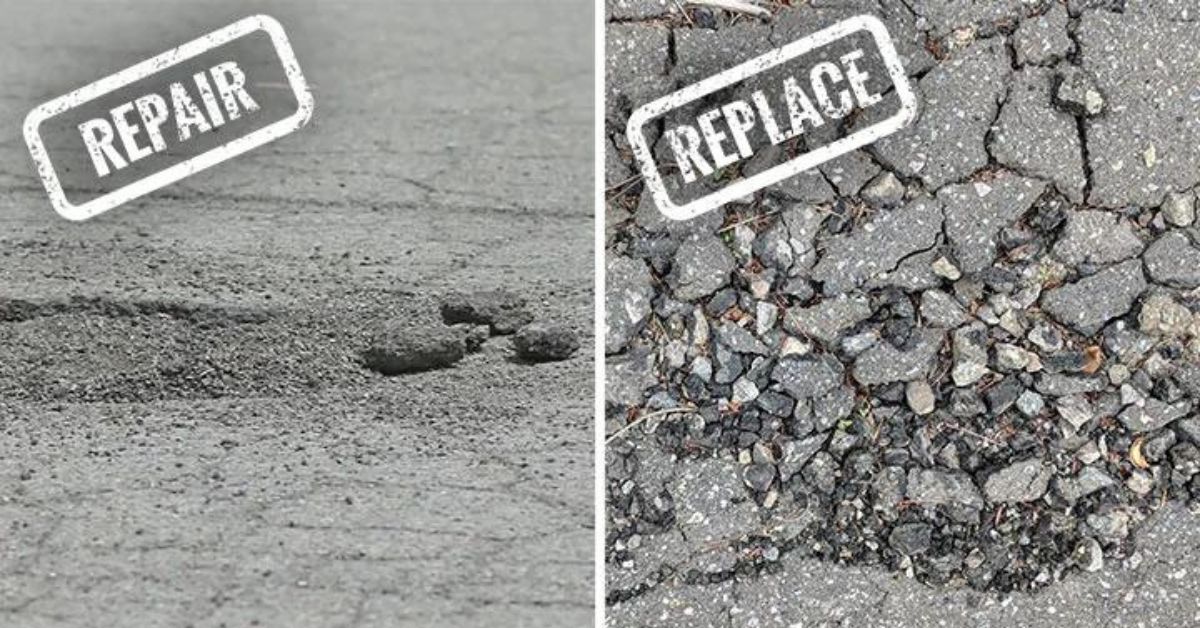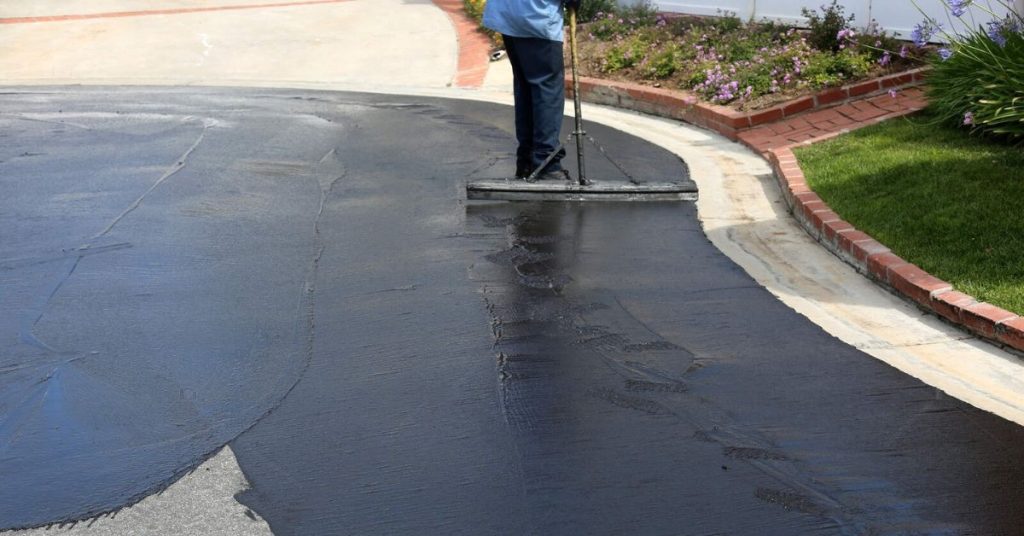When was the last time you had your driveway or parking lot inspected by an asphalt paving contractor? If it’s been ages, you may have noticed cracks and potholes. You might consider replacing or asphalt driveway resurfacing your parking lot to solve the issue. But before you rush into any decisions, it’s essential to understand the difference between resurfacing and replacement.
By grasping the dissimilarities between these two options, you can save cash and extend the lifespan of your asphalt driveway resurfacing. So, let’s delve into the topic and stock you with the extensive knowledge you need to make the right choice.
Asphalt Resurfacing
Resurfacing is removing the top layer of asphalt and adding a new one. You can put off repairing your parking lot or driveway for another 9 to 14 years by resurfacing it if the asphalt pavement’s base is undamaged.
You should work with a trustworthy asphalt resurfacing company, like us, for the project. The effects of asphalt resurfacing won’t last if this doesn’t materialize.
Potholes, fractures, and divots in the asphalt must be filled before resurfacing. This is because the fresh coating will only be as durable as the asphalt that lies beneath it.
Conditions Applied To Resurface Asphalt Driveway
Here are the following conditions that require your consideration;
- Repairs are only necessary on 25% to 30% of asphalt pavement.
- The structure of the foundation is strong.
- The age of asphalt pavement is under 20.
Resurfacing an asphalt driveway won’t be sufficient to replace your asphalt pavement if it needs to be replaced. Structure-related damage will quickly become visible on the new surface through cracks and potholes. Paying to resurface asphalt might be less costly in the short term, but the ongoing maintenance will cost you more. Good news! Our asphalt replacement specialists will be able to spot signs that indicate that the asphalt needs to be replaced.
Asphalt Resurfacing Process
Let’s take a brief overview of the asphalt resurfacing process:
- Evaluation: A professional asphalt contractor will assess the condition of your pavement to determine if it is suitable for resurfacing. They will look for signs of extensive damage, deep cracks, or underlying structural issues that may require repaving the asphalt driveway instead.
- Cleaning and Preparation: Before resurfacing, the existing pavement will be thoroughly cleaned to remove dirt, debris, and vegetation. Any necessary repairs, such as filling cracks or patching potholes, will be performed at this stage. It is crucial to have a smooth and clean surface for optimal adhesion of the new asphalt layer.
- Bonding Layer: A bonding layer, known as a tack coat, is applied to the cleaned and prepared surface. This layer improves the adhesion between the existing pavement and the new asphalt layer, ensuring a solid bond.
- Asphalt Overlay: Using specialized equipment, a fresh layer of hot mix asphalt is spread over the existing pavement. The thickness of the overlay will depend on your pavement’s specific requirements and the contractor’s recommendations.
- Compaction: The newly applied asphalt is compacted using heavy rollers or a paving machine to achieve proper density and smoothness. This step helps to ensure a durable and even surface.
- Finishing Touches: Once the compaction is complete, any necessary markings, such as parking lines or symbols, can be applied to the surface. Additionally, the edges of the resurfacing asphalt driveway area can be trimmed and sealed to create a neat and finished appearance.
- Curing Time: The new asphalt overlay needs time to cure and harden before it can withstand regular traffic. The curing time depends on factors such as weather conditions and the type of asphalt used. It’s essential to follow the instructions of top-tier asphalt maintenance company regarding when it is safe to use the newly resurfaced area.
Reminder: It is essential to note that better solutions exist than resurfacing asphalt driveway with damaged or structurally compromised pavements. In such cases, replacement may be necessary for a long-lasting and safe driveway or parking lot.
Asphalt Replacement
This process entails completely tearing down and removing the old asphalt surface to install brand-new asphalt. With this technique, the asphalt subgrade is leveled and compacted to ensure it is solid and avoids dipping or sliding. A fresh asphalt layer would be laid down to create a brand-new floor. If the new asphalt pavement receives the proper care and maintenance, it will last many years.
Although replacing the roads is usually only necessary in extreme cases, asphalt resurfacing is frequently a viable choice. Replacing costs extra, but your driveway or parking lot will last twice as long. It enables you to “start fresh” with a surface devoid of apparent flaws or major weaknesses.
Conditions Applied To Asphalt Replacing
Rules of resurface or replace asphalt driveways are different. Check out the following conditions before applying Asphalt Replacing:
- More than 25 to 30 percent of the paved surface needs work.
- Your pavement’s age exceeds 20 years.
- A few inches-deep cracks have appeared in your pavement.
- A fragile foundation.
- Over a quarter-inch wide fractures have appeared in your pavement.
Asphalt Replacement Process
Do you need to rebuild your repaving driveways driveway or parking lot? To ensure an ideal outcome, employing a concrete contractor with experience is advised. The steps listed below should be followed to complete the task:
Removal and Demolition
The initial procedure is to crush and replace the old repaving asphalt driveway layer with heavy equipment. After that, the contractor will remove the trash, leaving a fresh surface for flooring.
Excavation
To ensure the top of the driveway is comparatively higher than the lower section, the contractor will dig the area. This will result in proper water drainage, slow down any early driveway deterioration, and stop the property from flooding.
Subgrade Application
The contractor will evenly spread the subgrade material throughout the pavement surface using rakes and shovels. After that, it is compacted and watered down to create a sturdy foundation for the upcoming driveway. It is damp and compressed to provide a sturdy support framework for the forthcoming pavement. Both repaving driveways and resurfacing asphalt can be done using this method.
Surface and Binder Course
Any soft areas will be found and repaired after installing the subgrade. After that, the binder (a big aggregate combined with oil) will be added, making it extremely firm and durable.
Install a Fresh Asphalt Driveway
After laying the new surface, the contractor will put the top layer to provide a smooth, safe ride.
Final Roll
This time is for the magic of top rolling techniques. After the asphalt installation, the contractor uses a roller truck to compact and smooth the entire surface.
Wrap Up!
Making the right decision on asphalt resurfacing vs. replacement is crucial to avoid unnecessary costs and ensure the longevity of your pavement. Paying attention to warning signs and seeking professional advice when evaluating your pavement’s condition is essential.
Going for resurfacing when replacement is needed, or vice versa, can lead to additional expenses and unsatisfactory results. Consulting with an experienced asphalt contractor will provide you with the necessary expertise. They will assess the condition of your driveway accurately and recommend the most appropriate solution.
By investing in the proper asphalt maintenance and repair strategies, you can extend the life of your driveway or parking lot. Furthermore, it can save time, money, and headaches in the long run.







